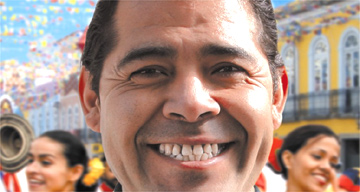
How do you sum up a country like San Sombrèro? Try thinking of Cuba in the 1950s, crossed with Manchester in the 1980s. Then add rum. That's the magic of this often-overlooked Central American jewel. And now, thanks to Jetlag's new travel guide, would-be visitors can learn all they need to know about planning a trip to sizzling San Sombrèro.
From when to go (there are two main seasons: the wet and the rainy), what to see (Madame Tussaud's first-ever Brazilian Wax Museum), what to avoid (the Cucaracha City snake petting-zoo) and even what to bring home (a gift pack of decaffeinated cocaine is sure to be a hit).
So much to do
From the frenetic nightlife of its capital, Cucaracha City, to the guaranteed solitude of a west coast beach during sea-snake season, there's simply so much to see and do in this exotic, tropical jewel. More than anything else, San Sombrèro is a land of fascinating contradictions, where Catholic churches permit animal sacrifices, and school canteens sell rum. Its people, too, are an intriguing mix, making it little wonder that San Sombrèro boasts the only Nobel Peace Prize winner ever to be accused of war crimes.
Straddling the azure waters of the Caribbean and Pacific, San Sombrèro's first foreign visitor was Jorge Paradoure, Spain's most short-sighted explorer who confidently identified the land mass as China before stepping ashore and planting a Spanish flag into his own foot (for more, see History section). The country was then colonised and the influence of Spain on the San Sombrèran people remains strong to this day, in their language, cuisine and fundamental inability to be anywhere on time.
Something for everyone
Despite its relatively small size, San Sombrèro offers so many options. Its capital is home to one of the world's largest Latin-music festivals, and organisers boast that each year almost 10,000 people turn up for the event, partly making up for the fifty-odd thousand who routinely flee the city.
Then there's historic centres, such as the colonial settlement of Fumarolé, home to the magnificently preserved presidential palace where, on weekends, visitors might be lucky enough to catch a glimpse of brightly dressed state guards driving military vehicles round the parade grounds while letting off firearms: This is not an official display - they're generally just drunk.
Further afield in the mountain hamlet of Cohlera you'll find the stately cathedral of San Pedro, noted for its massive organ, as was he. And for those wanting to simply relax, head for the dazzling off-white sands of resort cities such as Playa Miguel, where the adventurous traveller can catch a wave, a fish, a hot band and dengue fever all in the one day.
Dirty dancing!
Of course, no introduction to San Sombrèro would be complete without reference to the country's passion for song and dance. The traditional music of San Sombrèro is considered to be as infectious as many of the nation's water-borne diseases and, as for dancing, it doesn't get much hotter than the bababumba, the national dance of San Sombrèro.
Similar to a rumba, the bababumba enacts a breezy battle between a man and a woman who tries to parry his insistent advances. Truth be told, this dance is a thinly disguised simulation of the sexual act and will generally end in a passionate embrace followed, in many cases, by pregnancy.
Beautiful people
But more than anything else, it is the people of San Sombrèro who many regard as the main attraction, and first-time visitors are invariably struck by the natural beauty of its citizens. This is a country where ugliness (or 'aranche') is officially classified as a disability and even prisoners have solarium rights.
The San Sombrèran women, in particular, proudly flaunt their looks and sexuality, with baby girls often learning to shimmy before they can walk. And, despite moves to ban the practice, female soldiers serving in San Sombrèran regiments frequently disobey orders by re-designing their combat uniforms to create a bare midriff.
Sex in the city
Whether it's the steamy climate, Latin passion or a fundamental lack of self-control, San Sombrèrans certainly can't seem to keep their hands off each other, and on just about every street corner you'll see couples in passionate embrace, whether they're lovers, a married couple or just someone asking for directions.
Trouble in paradise
Of course, San Sombrèro is not a country without its problems. Political instability has seen 17 different presidents take power in the past decade, the shortest reign being that of Alivio Escrevez who was assassinated halfway through his own inauguration speech. (His assailant was later identified as the Chief Justice who was officiating at the swearing-in ceremony and who himself went on to become president.)
The economy, too, continues to struggle with recessions, depressions, devaluations and financial crises regularly plaguing the country. Of course, San Sombrèro's struggle for economic buoyancy has not been helped by the fact its people observe 362 separate public holidays (not counting the carnivale long weekend).
But it's not all gloom. A recent campaign to wipe out illiteracy has enjoyed great success, with over 53,000 citizens who were unable to read having now been jailed or deported to Haiti.
But for all its political and economic reforms, San Sombrèro remains a third-world country, one in which tourism plays a massively important role. Here taxi drivers earn more than doctors (though neither require formal qualifications) and new hotels open up just as quickly as the building inspectors can be bought off.
· The Jetlag spoof guide to San Sombrèro, published today by quadrille, is the sequel to Molvanîa and Phaic Tăn. More nonsense at jetlagtravel.com

